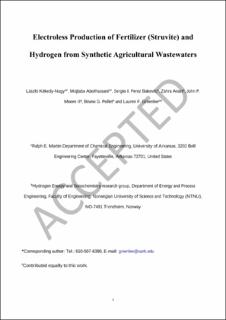| dc.contributor.author | Kékedy-Nagy, László | |
| dc.contributor.author | Abolhassani, Mojtaba | |
| dc.contributor.author | Bakovic, Sergio I. Perez | |
| dc.contributor.author | Anari, Zahra | |
| dc.contributor.author | Moore II, John P. | |
| dc.contributor.author | Pollet, Bruno | |
| dc.contributor.author | Greenlee, Lauren F. | |
| dc.date.accessioned | 2021-09-23T06:25:10Z | |
| dc.date.available | 2021-09-23T06:25:10Z | |
| dc.date.created | 2020-10-27T16:38:13Z | |
| dc.date.issued | 2020 | |
| dc.identifier.citation | Journal of the American Chemical Society. 2020, 142 18844-18858. | en_US |
| dc.identifier.issn | 0002-7863 | |
| dc.identifier.uri | https://hdl.handle.net/11250/2780604 | |
| dc.description.abstract | The drive toward sustainable phosphorus (P) recovery from agricultural and municipal wastewater streams has intensified. However, combining P recovery with energy conservation is perhaps one of the greatest challenges of this century. In this study, we report for the first time the simultaneous electroless production of struvite and dihydrogen from aqueous ammonium dihydrogen phosphate (NH4H2PO4) solutions in contact with either a pure magnesium (Mg) or a Mg alloy as the anode and 316 stainless steel (SS) as the cathode placed in a bench-scale electrochemical reactor. During the electroless process (i.e., in the absence of external electrical power), the open circuit potential (OCP), the formation of struvite on the anode, and the generation of dihydrogen at the cathode were monitored. We found that struvite is formed, and that struvite crystal structure/morphology and precipitate film thickness are affected by the concentration of the HnPO4n–3/NH4+ in solution and the composition of the anode. The pure Mg anode produced a porous 0.6–4.1 μm thick film, while the AZ31 Mg alloy produced a more compact 1.7–9.9 μm thick struvite film. Kinetic analyses revealed that Mg dissolution to Mg2+ followed mostly a zero-order kinetic rate law for both Mg anode materials, and the rate constants (k) depended upon the struvite layer morphology. Fourier-transform infrared spectrometry, X-ray diffraction, and scanning electron microscopy indicated that the synthesized struvite was of high quality. The dihydrogen and Mg2+ in solution were detected by a gas chromatography–thermal conductivity detector and ion chromatography, respectively. Furthermore, we fully demonstrate that the reactor was able to remove ∼73% of the HnPO4n–3 present in a natural poultry wastewater as mainly struvite. This study highlights the feasibility of simultaneously producing struvite and dihydrogen from wastewater effluents with no energy input in a green and sustainable approach. | en_US |
| dc.language.iso | eng | en_US |
| dc.publisher | American Chemical Society | en_US |
| dc.title | Electroless Production of Fertilizer (Struvite) and Hydrogen from Synthetic Agricultural Wastewaters | en_US |
| dc.type | Peer reviewed | en_US |
| dc.type | Journal article | en_US |
| dc.description.version | acceptedVersion | en_US |
| dc.rights.holder | Locked until 21.10.2021 due to copyright restrictions. This document is the Accepted Manuscript version of a Published Work that appeared in final form in [Journal of the American Chemical Society], copyright © American Chemical Society after peer review and technical editing by the publisher. | en_US |
| dc.source.pagenumber | 18844-18858 | en_US |
| dc.source.volume | 142 | en_US |
| dc.source.journal | Journal of the American Chemical Society | en_US |
| dc.identifier.doi | 10.1021/jacs.0c07916 | |
| dc.identifier.cristin | 1842702 | |
| cristin.ispublished | true | |
| cristin.fulltext | postprint | |
| cristin.qualitycode | 2 | |
